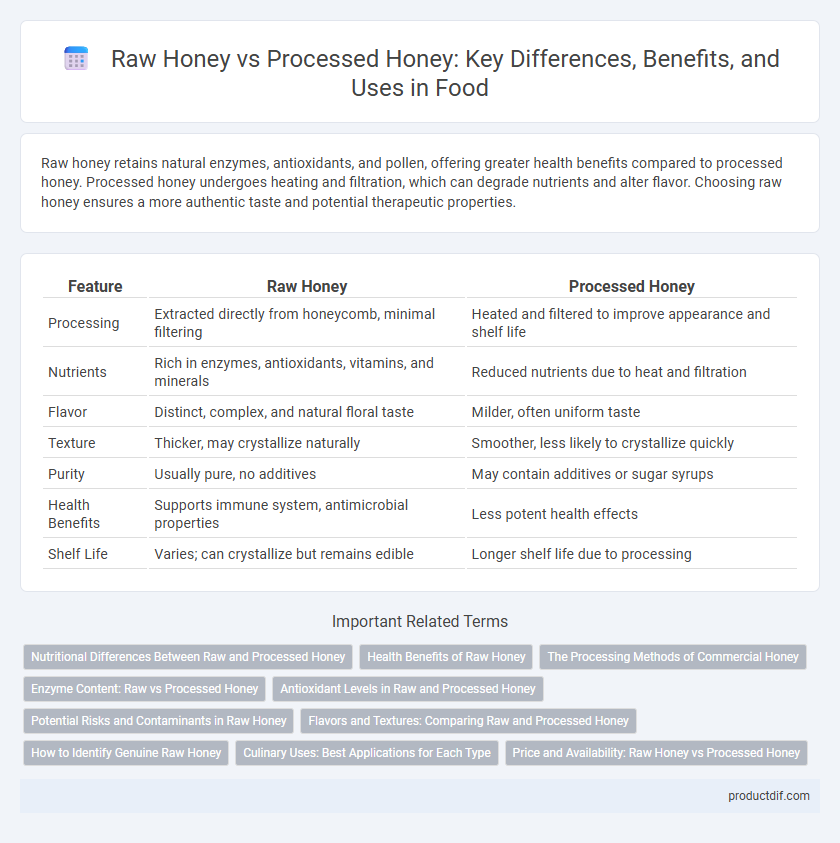Raw honey retains natural enzymes, antioxidants, and pollen, offering greater health benefits compared to processed honey. Processed honey undergoes heating and filtration, which can degrade nutrients and alter flavor. Choosing raw honey ensures a more authentic taste and potential therapeutic properties.
Table of Comparison
| Feature | Raw Honey | Processed Honey |
|---|---|---|
| Processing | Extracted directly from honeycomb, minimal filtering | Heated and filtered to improve appearance and shelf life |
| Nutrients | Rich in enzymes, antioxidants, vitamins, and minerals | Reduced nutrients due to heat and filtration |
| Flavor | Distinct, complex, and natural floral taste | Milder, often uniform taste |
| Texture | Thicker, may crystallize naturally | Smoother, less likely to crystallize quickly |
| Purity | Usually pure, no additives | May contain additives or sugar syrups |
| Health Benefits | Supports immune system, antimicrobial properties | Less potent health effects |
| Shelf Life | Varies; can crystallize but remains edible | Longer shelf life due to processing |
Nutritional Differences Between Raw and Processed Honey
Raw honey retains more natural enzymes, antioxidants, vitamins, and minerals compared to processed honey, which often undergoes pasteurization and filtration that can reduce these beneficial nutrients. The heating process in processed honey may degrade heat-sensitive compounds like flavonoids and phenolic acids, diminishing its antibacterial and anti-inflammatory properties. Nutritionally, raw honey provides higher levels of pollen, propolis, and trace enzymes, contributing to its superior health benefits over processed varieties.
Health Benefits of Raw Honey
Raw honey retains its natural enzymes, antioxidants, and phytonutrients, providing superior health benefits compared to processed honey. Its antimicrobial properties support wound healing and digestive health, while antioxidants help reduce oxidative stress and inflammation. Consuming raw honey can enhance immune function and promote overall wellness due to its minimally altered composition.
The Processing Methods of Commercial Honey
Commercial honey undergoes various processing methods including pasteurization, filtration, and blending, which remove impurities and enhance shelf life but may reduce natural enzymes and antioxidants. Raw honey is extracted directly from honeycombs and minimally processed, preserving pollen, propolis, and beneficial nutrients that contribute to its health benefits. Processing methods often involve heating to kill yeast cells and slow crystallization, but excessive heat can degrade honey's flavor and nutritional value.
Enzyme Content: Raw vs Processed Honey
Raw honey retains a high level of natural enzymes such as diastase, invertase, and glucose oxidase, which are essential for digestion and antimicrobial properties. Processed honey undergoes heat treatment and filtration, causing significant enzyme degradation and loss of beneficial compounds. Enzyme content in raw honey contributes to its superior health benefits compared to processed honey, which lacks these bioactive components.
Antioxidant Levels in Raw and Processed Honey
Raw honey contains significantly higher antioxidant levels compared to processed honey due to minimal heat exposure and filtration, preserving phenolic compounds and enzymes. Processing methods such as pasteurization and fine filtering reduce these antioxidants by breaking down sensitive bioactive substances. Consuming raw honey provides enhanced health benefits through greater antioxidant capacity, which helps combat oxidative stress and supports overall wellness.
Potential Risks and Contaminants in Raw Honey
Raw honey may contain potential contaminants such as pollen, bee parts, and natural yeasts that pose minimal health risks but can be problematic for sensitive individuals. It can also harbor Clostridium botulinum spores, which are especially dangerous to infants under one year old, leading to botulism poisoning. Unlike processed honey that undergoes pasteurization and filtration to reduce microbial content and impurities, raw honey retains more natural enzymes and compounds but requires careful handling to mitigate health risks.
Flavors and Textures: Comparing Raw and Processed Honey
Raw honey offers complex floral flavors and a thicker, grainy texture due to natural pollen and enzymes, providing a rich sensory experience. Processed honey undergoes heating and filtration, resulting in a smoother, more uniform texture but often loses delicate aromas and subtle flavor notes. Consumers seeking authentic taste and health benefits typically prefer raw honey, while processed honey appeals for its consistency and longer shelf life.
How to Identify Genuine Raw Honey
Genuine raw honey can be identified by its cloudy appearance and natural sediment, which indicate the presence of pollen and enzymes preserved during minimal processing. Unlike processed honey, raw honey crystallizes over time due to its natural glucose content, providing a key sign of authenticity. Testing by placing a small drop on a paper towel also helps; genuine raw honey doesn't immediately absorb or dissolve, confirming its purity.
Culinary Uses: Best Applications for Each Type
Raw honey retains its natural enzymes and distinct floral flavors, making it ideal for drizzling over yogurt, adding to salad dressings, and enhancing baked goods that benefit from a complex taste. Processed honey, with its smooth texture and consistent sweetness, works well as a sweetener in beverages, marinades, and recipes requiring uniform caramelization. Chefs often select raw honey for artisan dishes and processed honey for mass-produced baked items due to differences in flavor intensity and texture stability.
Price and Availability: Raw Honey vs Processed Honey
Raw honey typically commands a higher price due to its limited availability and labor-intensive harvesting methods, often sourced from local or small-scale beekeepers. Processed honey is widely available in supermarkets at a lower cost because of mass production, filtration, and pasteurization processes that extend shelf life and ensure uniform texture. Consumers seeking natural nutrients often pay a premium for raw honey's perceived purity, while processed honey offers affordability and convenience.
raw honey vs processed honey Infographic

 productdif.com
productdif.com